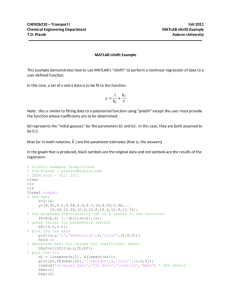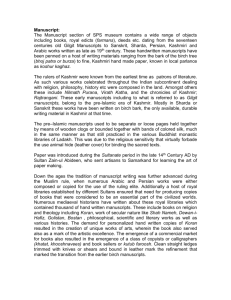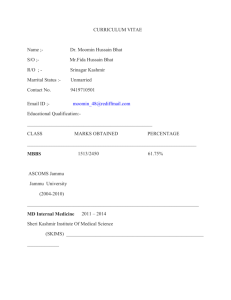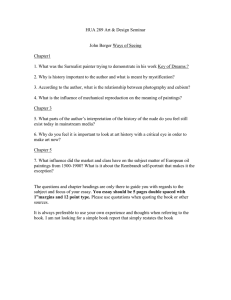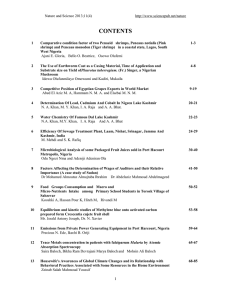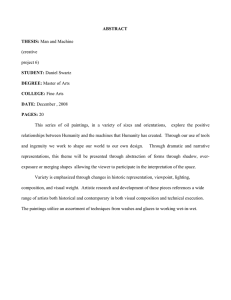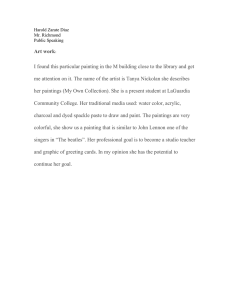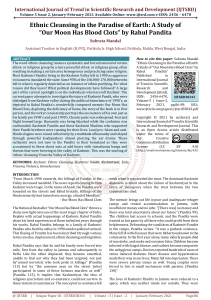OLD MANUSCRIPTS …… OF VILLAGE MURRAN
advertisement
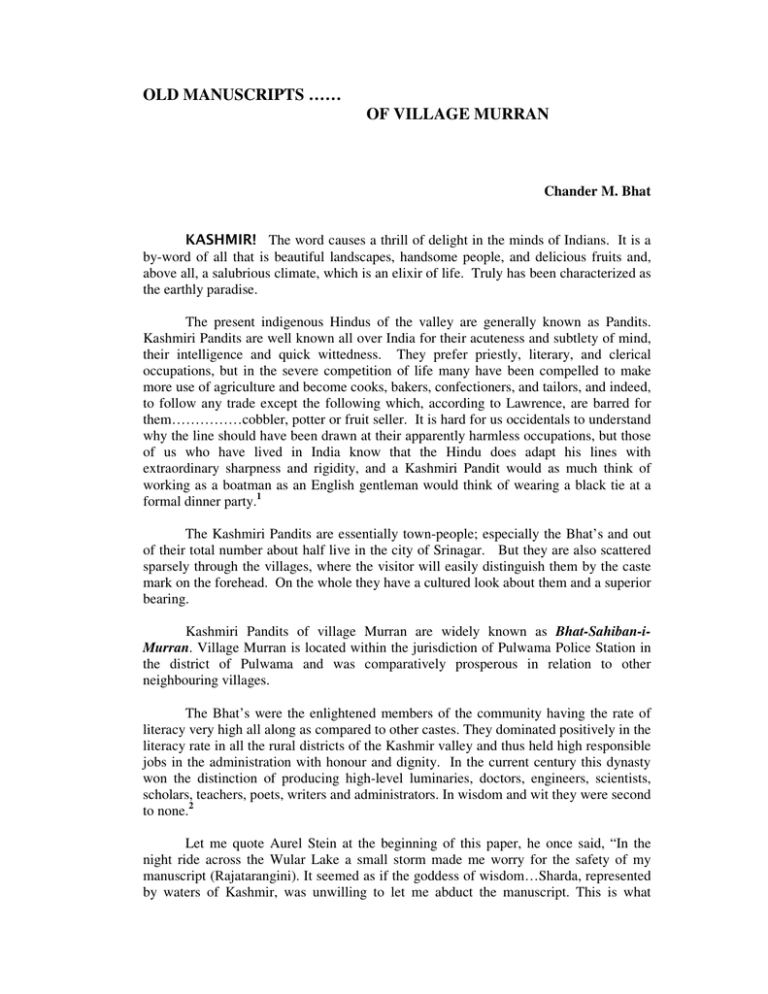
OLD MANUSCRIPTS …… OF VILLAGE MURRAN Chander M. Bhat KASHMIR! The word causes a thrill of delight in the minds of Indians. It is a by-word of all that is beautiful landscapes, handsome people, and delicious fruits and, above all, a salubrious climate, which is an elixir of life. Truly has been characterized as the earthly paradise. The present indigenous Hindus of the valley are generally known as Pandits. Kashmiri Pandits are well known all over India for their acuteness and subtlety of mind, their intelligence and quick wittedness. They prefer priestly, literary, and clerical occupations, but in the severe competition of life many have been compelled to make more use of agriculture and become cooks, bakers, confectioners, and tailors, and indeed, to follow any trade except the following which, according to Lawrence, are barred for them……………cobbler, potter or fruit seller. It is hard for us occidentals to understand why the line should have been drawn at their apparently harmless occupations, but those of us who have lived in India know that the Hindu does adapt his lines with extraordinary sharpness and rigidity, and a Kashmiri Pandit would as much think of working as a boatman as an English gentleman would think of wearing a black tie at a formal dinner party.1 The Kashmiri Pandits are essentially town-people; especially the Bhat’s and out of their total number about half live in the city of Srinagar. But they are also scattered sparsely through the villages, where the visitor will easily distinguish them by the caste mark on the forehead. On the whole they have a cultured look about them and a superior bearing. Kashmiri Pandits of village Murran are widely known as Bhat-Sahiban-iMurran. Village Murran is located within the jurisdiction of Pulwama Police Station in the district of Pulwama and was comparatively prosperous in relation to other neighbouring villages. The Bhat’s were the enlightened members of the community having the rate of literacy very high all along as compared to other castes. They dominated positively in the literacy rate in all the rural districts of the Kashmir valley and thus held high responsible jobs in the administration with honour and dignity. In the current century this dynasty won the distinction of producing high-level luminaries, doctors, engineers, scientists, scholars, teachers, poets, writers and administrators. In wisdom and wit they were second to none.2 Let me quote Aurel Stein at the beginning of this paper, he once said, “In the night ride across the Wular Lake a small storm made me worry for the safety of my manuscript (Rajatarangini). It seemed as if the goddess of wisdom…Sharda, represented by waters of Kashmir, was unwilling to let me abduct the manuscript. This is what happened 1200 years ago to the Chinese pilgrim Hiuen-Tsang, who had to leave his Sanskrit manuscript in the angry Indus River.” Kashmir was full of manuscripts and most of them have been sold or taken to western countries. Pandit Gulab Bhat (1837-1909) of village Murran has written Srimad Bhagvad Gita by hand on birch-bark ‘Burzah’ with beautiful paintings and the same is lying with the author. This work is a masterpiece. [Paintings forming the part of a handwritten book written by Pandit Gulab Bhat] One of the member of this village namely Pandit Haldar Bhat (1850-1944) has translated Srimad Bhagvad Gita in Persian and the manuscript copy is still lying with one of the members of village Murran namely Shri Pairey Lal Pandita (Shangroo). [A page from a handwritten book written by Pandit Gulab Bhat on birch-bark] Dr. S. S. Toshkhani of the Nityanand Shastri Kashmir Research Institute (NSKRI) core group observed that it was agonizing that priceless treasures of Kashmiri Pandit heritage old manuscripts, paintings, pieces of art have been irretrievably lost or irreparably damaged as a result of the fundamentalist’s depredations and our own unconcern. What is still left - lies scattered in a state of callous neglect. Another top priority item on the agenda of NSKRI is the compilation of the first ever album of Kashmiri miniature paintings. No systematic study of the Kashmiri school of art has been attempted so far and no one has ventured to prepare an album of these miniatures, notwithstanding their importance in the overall context of the history of Indian art, the Kangra and Pahari styles being but offshoots of this precious school of art. While a large number of such paintings have been lost - sold by their unscrupulous owners or others to foreigners and private art collectors in the country in a most callous manner, the Institute has managed to acquire about two dozen Kashmiri miniature paintings and is in the process of acquiring more. The album will be published with an introduction and critical assessment of individual paintings included in it. [A page of a handwritten book written by Pandit Gulab Bhat on birch-bark] The French Sinologist M. Pelliot visited Turkistan in 1906-08 and discovered Sanskrit manuscripts written in the Tang period. He also discovered Buddhist Mural paintings of the seventh to tenth centuries at Tun-huang. The old manuscripts were written in Sanskrit, Pali, Prakrit and the Kushan dialects on birch-bark which was, no doubt exported to Central Asia from Kashmir.3 [A page from a handwritten book written by Pandit Gulab Bhat on birch-bark] [Paintings forming the part of a handwritten book written by Pandit Gulab Bhat] REFERENCES 1. 2. 3. 4. Sir Francis Younghusband: Kashmir T.N.Bhat: Introductory Note to Genealogical Tree. R. S. Pandit, The River of Kings; pp 605-6 P. N. Koul Bamzai, Cultural & Political History of Kashmir; Chapter 2
